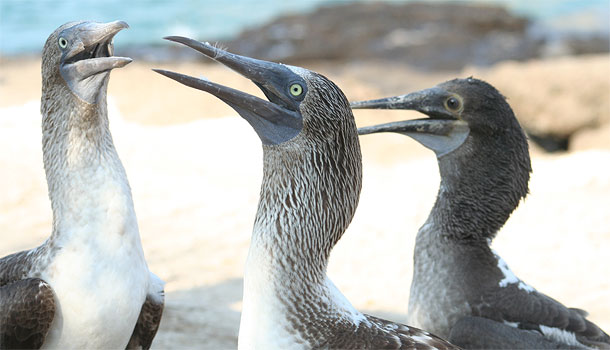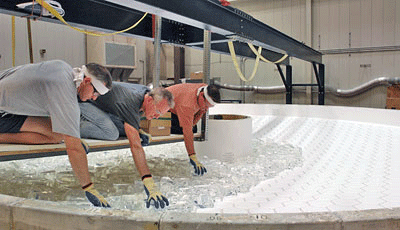
Crossing borders to kick-start novel research
Wednesday 28 September 2011
Scientists in Mexico and at UC study the breeding habits of a remarkable seabird for possible clues about behavioral evolution and how animals may develop immunities. The project is one of many research collaborations supported by UC MEXUS.
Isla Isabela is a small island off the west coast of Mexico, just south of the southern tip of Baja. The total land mass is about 200 acres, about the size of the central campus of UC Berkeley, though about 50 of those acres are taken up by a salty crater lake.
There’s not much to see on Isla Isabela — it’s lightly forested with a few nice beaches and crystal blue water, but no one lives there. Well, no humans, anyway. For the past 30 years, Hugh Drummond has run a research program with the island’s roughly 2,000 pairs of nesting blue–footed boobies (in photo above), a comical seabird with an awkward gait.
Though the bird might look a little ridiculous and lack the caché of its distant cousin, the cormorant, it’s a treasure trove of clues into the evolution of behavior. Part of this is the fantastically complex breeding habits of the bird; part of it is because they simply aren’t very shy about mating.
“With the boobies, they’re so accessible. It all goes on right in front of you,” says Drummond, who heads the ecology program at Universidad Nacional Autónoma de México (UNAM), Mexico’s biggest university. “You can just sit there and watch it all.”
Drummond’s team makes detailed lists of who is paired with whom and how their offspring turn out. His work is ambitious and varied, and research on the island has led to dozens of papers in international journals. It’s inexpensive research compared with, say, satellite astronomy; yet sometimes funding can be hard to find, especially for out-of-the-box ideas.
Mexico has enormous natural resources and a vibrant academic community that has long partnered with its neighbor to the north. Yet recent friction between Mexico and the United States has made it difficult for researchers in the two countries to work together. Thankfully, a unique institute with a collaborative and binational focus called UC MEXUS (the University of California Institute for Mexico and the United States) fills in the gaps needed to kick-start new ideas.
For one of his current projects, Drummond wanted to look at how boobies select their mates. A conversation with longtime friend and colleague Patty Gowaty at UCLA’s Department of Ecology and Environmental Biology led to both being inspired about a fascinating idea in behavioral evolution.
In recent years scientists have begun to link mate selection to immunities in a host of different animals. That is, females seem to choose males who have different immunities to disease than themselves. This makes some sense, since it would ensure that their young would theoretically then have the widest repertoire of immunities possible. In fact, startling research in humans has suggested we do something similar when we smell the body odors of members of the opposite sex.
However, very little is known about how this happens — presuming that it does — and how many species do it. With his long history of tracking mating birds, Drummond’s site is a perfect petri dish for this work.
Most scientists say birds have a bad sense of smell, which is how mammals likely pick up on the cues. Even so, it seems that the birds can devise a sense of a potential mate’s immunity profile. The UC MEXUS-funded study will attempt to answer this with an exhaustive list of bird immunity genes to compare against one another.
“Even as we sit here chatting, there are people removing blood from boobies and their offspring on the island,” says Drummond, but “we don’t even know if we can do the analyses.”
It all hinges on whether one of Gowaty’s researchers — Brant Faircloth, a whiz at working with genome-level comparisons — can come up with a brand new technology. Until now, scientists studying birds mostly look at specific sections of DNA but can’t zoom out to look at the whole thing.
It’s exactly the kind of ambitious collaborative research that can be hard to fund right now. So Drummond turned to UC MEXUS. The institute was set up in 1980 to build ties between Mexico and the UC system, allowing students and faculty from both sides of the border to benefit from the resources of the other. With a roughly $5 million budget, the organization sponsors more than 60 Ph.D. students and some 20 postdoctoral fellows every year. It also sponsors more than 100 grants annually for researchers and students whose academic interests involve Mexico or Latinos in the United States.
The founders, including legendary Mexican ethnobotanist Arturo Gómez-Pompa, set up the program to allow UC faculty and researchers to work in Mexico while encouraging stints for Mexican scientists at UC campuses. From the beginning, they specialized in small startup grants ignored by bigger funders.
“Our projects are small by most standards,” says Exequiel Ezcurra, director of UC MEXUS, based in UC Riverside. “The idea is that we believe in people when nobody believes in them.”

Two years ago, casting team members loaded 22,500 pounds of special glass into the 6.5-meter honeycomb mold for the San Pedro Mártir Observatory mirror. Credit: Ray Bertram, Steward Observatory, University of Arizona
And it works. UC MEXUS invested $25,000 in a group of researchers from UC Berkeley, the University of Arizona, Mexico’s Institute of Astrophysics and Optics (INAOE) and UNAM who wanted to build an infrared telescope in Baja California. The money mostly covered a few meetings at the various campuses and plane tickets. Yet that small investment kicked off the $200 million San Pedro Mártir Telescope, slated for completion in 2017.
Ezcurra says it’s a tough time, however, for cross-border partnerships with Mexico. In addition to tight public funding, hostilities between the governments over the drug trade and violence along the border have had a ripple effect over research. A similar program at the University of Arizona is in jeopardy, and four Mexican universities have halted cross-border exchange programs. Ezcurra says that toxic political rhetoric has a way of corrupting academic endeavors. A recent letter in the journal Science specifically blames proposed Arizona legislation requiring police to check for proof of citizenship for sparking chilly relations.
UC MEXUS, however, appears strong and has even inspired a nascent relationship between UC and Chile. Projects studying everything from the origins of vanilla to the roots of ranchero music to the beginnings of life continue to receive funding. A symposium on pollution and the Emmy Award-winning documentary "Presumed Guilty," produced by two UC Berkeley public policy graduate students, also were supported by UC MEXUS.
Meanwhile, Drummond, Faircloth and Gowaty got their money to study blue-footed boobies. Faircloth says he’s a little nervous about the daunting task ahead. If it works, scientists across the world will be able to more easily examine and compare entire bird genomes — to say nothing about finding another hint of how one funny little bird picks its mate.